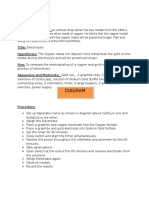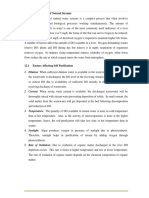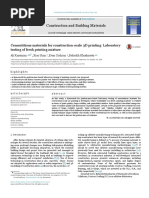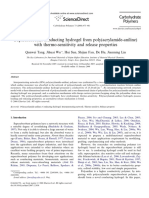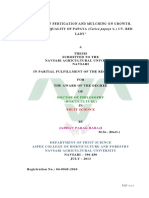Dissolved Oxygen in Waste Water: Experiment No.4
Uploaded by
MazharYasinDissolved Oxygen in Waste Water: Experiment No.4
Uploaded by
MazharYasinEnvironmental Engineering -II October 20, 2016
EXPERIMENT NO.4
DISSOLVED OXYGEN IN WASTE WATER
Table of Contents
4.1 OBJECTIVE........................................................................................................................... 25
4.2 APPARATUS ......................................................................................................................... 25
4.3 REAGENTS ........................................................................................................................... 25
4.4 RELATED THEORY ............................................................................................................. 25
4.4.1 DISSOLVED OXYGEN ............................................................................................. 25
4.4.2 SOURCE OF DO ....................................................................................................... 25
4.4.3 FACTORS EFFECTING DO..................................................................................... 26
4.4.4 THRESHOLD VALUES: ............................................................................................ 26
4.5 ENVIRONMENTAL SIGNIFICANCE: .................................................................................. 26
4.5.1 AQUATIC LIFE .......................................................................................................... 26
4.5.2 GAS BUBBLE DISEASE........................................................................................... 26
4.5.3 INDICATOR OF WATER QUALITY ......................................................................... 27
4.5.4 NATURAL STREAM PURIFICATION PROCESSES ............................................. 27
4.5.5 AEROBIC CONDITIONS .......................................................................................... 27
4.5.6 BASIS FOR BOD ....................................................................................................... 27
4.6 PROCEDURE ....................................................................................................................... 27
4.7 OBSERVATIONS AND CALCULATIONS .......................................................................... 28
4.8 COMMENTS:......................................................................................................................... 28
4.9 REFERENCES ...................................................................................................................... 28
MAZHAR YASIN (BSCE0133122) 24
Environmental Engineering -II October 20, 2016
4.1 OBJECTIVE
To determine the quantity of dissolved oxygen present in the given waste water
sample
4.2 APPARATUS
DO bottles
Pipette
DO Meter
4.3 REAGENTS
MgSO4
FeCL2
CaCl2
4.4 RELATED THEORY
4.4.1 DISSOLVED OXYGEN
Amount of oxygen dissolved in a body of waste water such as a lake, river, or stream,
is known as Dissolved Oxygen. DO is the most important indicator of the health of a
water body and its capacity to support a balanced aquatic ecosystem of plants and
animals.
UNITS
DO is usually expressed in milligrams per liter (mg/L) or Parts per million (ppm).
4.4.2 SOURCE OF DO
Oxygen gets into water bodies when:
Oxygen from the atmosphere dissolves and mixes into the waste water surface.
Water flowing (streams, rivers and oceans) have high speed, which helps
oxygen from the air to mix.
Photosynthesis in the water bodies
releases oxygen. Algae releases oxygen
during photosynthesis.
MAZHAR YASIN (BSCE0133122) 25
Environmental Engineering -II October 20, 2016
4.4.3 FACTORS EFFECTING DO
The physical factors that influence DO are:
How much oxygen is being produced by biological processes (such as
photosynthesis by plants)
Temperature inversely controls the solubility of oxygen in water; as temperature
increases, oxygen is less soluble
There is a direct relationship between atmospheric pressure and DO; as the
pressure increases due to weather or elevation changes, oxygen solubility
increases.
Salinity also reduces the solubility of oxygen in water.
Stream structure also influences DO concentrations. Atmospheric oxygen
becomes mixed into a stream at turbulent, shallow riffles, resulting in increased
DO levels.
4.4.4 THRESHOLD VALUES:
These values are set by according to the requirement of different specie living in water.
Good
Dissolved Oxygen= 5 mg/l
Fair
2 mg/l < Dissolved Oxygen< 5 Mg/L
Poor
2 mg/l< Dissolved Oxygen
4.5 ENVIRONMENTAL SIGNIFICANCE:
4.5.1 AQUATIC LIFE
Change in the dissolved oxygen levels can cause changes in the types and numbers
of aquatic macro invertebrates, plants and animals living in an ecosystem. Dissolved
oxygen levels change and vary according to the time of day, the weather and the
temperature. A decrease in the dissolved oxygen levels is usually an indication of an
entry of some organic pollutant.
4.5.2 GAS BUBBLE DISEASE
Total dissolved gas concentrations in water should not exceed 110 percent.
Concentrations above this level can be harmful to aquatic life. Fish in waters
containing excessive dissolved gases may suffer from "gas bubble disease"; however,
this is a very rare occurrence. The bubbles block the flow of blood through blood
vessels causing death. External bubbles can also occur and be seen on fins, on skin
and on other tissue
MAZHAR YASIN (BSCE0133122) 26
Environmental Engineering -II October 20, 2016
4.5.3 INDICATOR OF WATER QUALITY
Dissolved oxygen is absolutely essential for the survival of all aquatic organisms (not
only fish but also invertebrates such as crabs, clams, zooplankton, etc.). Moreover,
oxygen affects a vast number of other water indicators, not only biochemical but
aesthetic ones like the odor, clarity and taste.
4.5.4 NATURAL STREAM PURIFICATION PROCESSES
Adequate dissolved oxygen is necessary for good water quality. Oxygen is a
necessary element to all forms of life. Natural stream purification processes require
adequate oxygen levels in order to provide for aerobic life forms. As dissolved oxygen
levels in water drop below 5.0 mg/l, aquatic life is put under stress. The lower the
concentration, the greater the stress. Oxygen levels that remain below 1-2 mg/l for a
few hours can result in large fish kills.
4.5.5 AEROBIC CONDITIONS
The DO measurements are vital for maintaining aerobic conditions in natural waters
that receive pollution matter.
4.5.6 BASIS FOR BOD
Determinations of DO serve as the basis of the BOD test. The rate of biological
oxidation can be measured by determining residual dissolved oxygen in a system at
various intervals of time.
4.6 PROCEDURE
Take three samples of waste water
Fill each bottle with waste water sample.
Dilute the sample
Calibrate the DO meter according to the manufacturer's instructions.
Place the probe in the sample bottle.
Set the meter to measure temperature, and allow the temperature reading to
stabilize. Record the temperature
Switch the meter to read dissolved oxygen.
MAZHAR YASIN (BSCE0133122) 27
Environmental Engineering -II October 20, 2016
4.7 OBSERVATIONS AND CALCULATIONS
Sample Name Source DO of Sample Temperature oC
4.8 COMMENTS:
4.9 REFERENCES
http://www.chesapeakebay.net/discover/bayecosystem/dissolvedoxygen
http://www.fondriest.com/environmental-measurements/parameters/water
quality/dissolved-oxygen/
http://www.mymobilebay.com/stationdata/whatisDO.htm
MAZHAR YASIN (BSCE0133122) 28
You might also like
- Water Quality Analysis by Scientific MethodNo ratings yetWater Quality Analysis by Scientific Method5 pages
- (lab 3) ENE142-VIRTUAL LAB -SARAIL, PEDREGOSA, STA. TERESANo ratings yet(lab 3) ENE142-VIRTUAL LAB -SARAIL, PEDREGOSA, STA. TERESA4 pages
- Determination of The Dissolved Oxygen Content of WaterNo ratings yetDetermination of The Dissolved Oxygen Content of Water4 pages
- River Health.: Self-Purification Will Take Less Tim at Hot Temperature Than in WinterNo ratings yetRiver Health.: Self-Purification Will Take Less Tim at Hot Temperature Than in Winter4 pages
- 8 - WQM of Rivers - Streeter Phelps Model PDF100% (1)8 - WQM of Rivers - Streeter Phelps Model PDF65 pages
- Environmental Chemistry: Dissolved OxygenNo ratings yetEnvironmental Chemistry: Dissolved Oxygen17 pages
- Chapter 01 Introduction To Water Pollution and ControlNo ratings yetChapter 01 Introduction To Water Pollution and Control8 pages
- Environmental Engineering Lab: Eng. Aysha As-Hab Monday 2-5No ratings yetEnvironmental Engineering Lab: Eng. Aysha As-Hab Monday 2-53 pages
- Chemistry For Env - Eng. & Science, Sawyer, Mccarty, ParkinNo ratings yetChemistry For Env - Eng. & Science, Sawyer, Mccarty, Parkin22 pages
- Page No: Lab Manual of Environmental EngineeringNo ratings yetPage No: Lab Manual of Environmental Engineering19 pages
- CHEM181 Experiment8 DetermiantionofDissolvedOxygenNo ratings yetCHEM181 Experiment8 DetermiantionofDissolvedOxygen7 pages
- TBC 3013 Information and Communication Technology in Biology Data Logging Report "Biochemical Oxygen Demand"100% (6)TBC 3013 Information and Communication Technology in Biology Data Logging Report "Biochemical Oxygen Demand"12 pages
- Why Dissolved Oxygen Is Important: Environmental ImpactNo ratings yetWhy Dissolved Oxygen Is Important: Environmental Impact2 pages
- Determination of Dissolve Oxygen by Winkler Method100% (1)Determination of Dissolve Oxygen by Winkler Method7 pages
- Group 2A Scientific Paper On Determination of Dissolved Oxygen in A Body of WaterNo ratings yetGroup 2A Scientific Paper On Determination of Dissolved Oxygen in A Body of Water9 pages
- GR Effect of Turbulence On Dissolved Oxygen in WaterNo ratings yetGR Effect of Turbulence On Dissolved Oxygen in Water8 pages
- Part I: Introduction To Water Pollution and Control 1. Water Pollution 1.1water PollutantsNo ratings yetPart I: Introduction To Water Pollution and Control 1. Water Pollution 1.1water Pollutants8 pages
- Microbial Ecology of the OceansFrom EverandMicrobial Ecology of the OceansJosep M. GasolNo ratings yet
- Experiment No. 10: To Determine The Effect of Rate of Loading On The Compressive Strength of P.C.C Cube and CylinderNo ratings yetExperiment No. 10: To Determine The Effect of Rate of Loading On The Compressive Strength of P.C.C Cube and Cylinder3 pages
- Table: Assembled Joint Masses Joint Masssource U1 U2 U3 R1 R2 R3 CenterxNo ratings yetTable: Assembled Joint Masses Joint Masssource U1 U2 U3 R1 R2 R3 Centerx80 pages
- Structurepoint - Spcolumn V5.50 (TM) - 1869762670 Day Trial License. Locking Code: 4-31D37. User: Mazhar Yasin, MsceNo ratings yetStructurepoint - Spcolumn V5.50 (TM) - 1869762670 Day Trial License. Locking Code: 4-31D37. User: Mazhar Yasin, Msce1 page
- Structurepoint - Spcolumn V5.50 (TM) - 1869762670 Day Trial License. Locking Code: 4-31D37. User: Mazhar Yasin, MsceNo ratings yetStructurepoint - Spcolumn V5.50 (TM) - 1869762670 Day Trial License. Locking Code: 4-31D37. User: Mazhar Yasin, Msce1 page
- Akira Hirose - Lecture Notes ElectromagnetismNo ratings yetAkira Hirose - Lecture Notes Electromagnetism426 pages
- waste-management-internal-audit-checklist_14872No ratings yetwaste-management-internal-audit-checklist_1487210 pages
- Superabsorbent Conducting Hydrogel From Poly (Acrylamide-Aniline) With Thermo-Sensitivity and Release PropertiesNo ratings yetSuperabsorbent Conducting Hydrogel From Poly (Acrylamide-Aniline) With Thermo-Sensitivity and Release Properties9 pages
- Official - ncm1004 - Harlequin Listeria Chromogenic Agar According To Ottaviani and Agosti - Technical Specifications - en UsNo ratings yetOfficial - ncm1004 - Harlequin Listeria Chromogenic Agar According To Ottaviani and Agosti - Technical Specifications - en Us3 pages
- Sitrans FM Mag 3100 Magnetic Flow Sensor IcNo ratings yetSitrans FM Mag 3100 Magnetic Flow Sensor Ic16 pages
- EFFECT OF FERTIGATION AND MULCHING ON GROWTH, YIELD AND QUALITY OF PAPAYA (Carica Papaya L.) CV. RED LADYNo ratings yetEFFECT OF FERTIGATION AND MULCHING ON GROWTH, YIELD AND QUALITY OF PAPAYA (Carica Papaya L.) CV. RED LADY168 pages
- Uv-Vis Spectroscopy: CHM 3402 Dr. Mohd Rashidi Abdull ManapNo ratings yetUv-Vis Spectroscopy: CHM 3402 Dr. Mohd Rashidi Abdull Manap61 pages
- Vital Pulp Therapy For The Mature Tooth Can It WorkNo ratings yetVital Pulp Therapy For The Mature Tooth Can It Work8 pages
- Hydroforming Process: Ankush Avhad, Shyam Chandore, Mahendra AvhadNo ratings yetHydroforming Process: Ankush Avhad, Shyam Chandore, Mahendra Avhad5 pages
- Effect of Temperature in Enzyme ActivityNo ratings yetEffect of Temperature in Enzyme Activity4 pages
- (lab 3) ENE142-VIRTUAL LAB -SARAIL, PEDREGOSA, STA. TERESA(lab 3) ENE142-VIRTUAL LAB -SARAIL, PEDREGOSA, STA. TERESA
- Determination of The Dissolved Oxygen Content of WaterDetermination of The Dissolved Oxygen Content of Water
- River Health.: Self-Purification Will Take Less Tim at Hot Temperature Than in WinterRiver Health.: Self-Purification Will Take Less Tim at Hot Temperature Than in Winter
- Chapter 01 Introduction To Water Pollution and ControlChapter 01 Introduction To Water Pollution and Control
- Environmental Engineering Lab: Eng. Aysha As-Hab Monday 2-5Environmental Engineering Lab: Eng. Aysha As-Hab Monday 2-5
- Chemistry For Env - Eng. & Science, Sawyer, Mccarty, ParkinChemistry For Env - Eng. & Science, Sawyer, Mccarty, Parkin
- CHEM181 Experiment8 DetermiantionofDissolvedOxygenCHEM181 Experiment8 DetermiantionofDissolvedOxygen
- TBC 3013 Information and Communication Technology in Biology Data Logging Report "Biochemical Oxygen Demand"TBC 3013 Information and Communication Technology in Biology Data Logging Report "Biochemical Oxygen Demand"
- Why Dissolved Oxygen Is Important: Environmental ImpactWhy Dissolved Oxygen Is Important: Environmental Impact
- Determination of Dissolve Oxygen by Winkler MethodDetermination of Dissolve Oxygen by Winkler Method
- Group 2A Scientific Paper On Determination of Dissolved Oxygen in A Body of WaterGroup 2A Scientific Paper On Determination of Dissolved Oxygen in A Body of Water
- GR Effect of Turbulence On Dissolved Oxygen in WaterGR Effect of Turbulence On Dissolved Oxygen in Water
- Part I: Introduction To Water Pollution and Control 1. Water Pollution 1.1water PollutantsPart I: Introduction To Water Pollution and Control 1. Water Pollution 1.1water Pollutants
- Experiment No. 10: To Determine The Effect of Rate of Loading On The Compressive Strength of P.C.C Cube and CylinderExperiment No. 10: To Determine The Effect of Rate of Loading On The Compressive Strength of P.C.C Cube and Cylinder
- Table: Assembled Joint Masses Joint Masssource U1 U2 U3 R1 R2 R3 CenterxTable: Assembled Joint Masses Joint Masssource U1 U2 U3 R1 R2 R3 Centerx
- Structurepoint - Spcolumn V5.50 (TM) - 1869762670 Day Trial License. Locking Code: 4-31D37. User: Mazhar Yasin, MsceStructurepoint - Spcolumn V5.50 (TM) - 1869762670 Day Trial License. Locking Code: 4-31D37. User: Mazhar Yasin, Msce
- Structurepoint - Spcolumn V5.50 (TM) - 1869762670 Day Trial License. Locking Code: 4-31D37. User: Mazhar Yasin, MsceStructurepoint - Spcolumn V5.50 (TM) - 1869762670 Day Trial License. Locking Code: 4-31D37. User: Mazhar Yasin, Msce
- Superabsorbent Conducting Hydrogel From Poly (Acrylamide-Aniline) With Thermo-Sensitivity and Release PropertiesSuperabsorbent Conducting Hydrogel From Poly (Acrylamide-Aniline) With Thermo-Sensitivity and Release Properties
- Official - ncm1004 - Harlequin Listeria Chromogenic Agar According To Ottaviani and Agosti - Technical Specifications - en UsOfficial - ncm1004 - Harlequin Listeria Chromogenic Agar According To Ottaviani and Agosti - Technical Specifications - en Us
- EFFECT OF FERTIGATION AND MULCHING ON GROWTH, YIELD AND QUALITY OF PAPAYA (Carica Papaya L.) CV. RED LADYEFFECT OF FERTIGATION AND MULCHING ON GROWTH, YIELD AND QUALITY OF PAPAYA (Carica Papaya L.) CV. RED LADY
- Uv-Vis Spectroscopy: CHM 3402 Dr. Mohd Rashidi Abdull ManapUv-Vis Spectroscopy: CHM 3402 Dr. Mohd Rashidi Abdull Manap
- Vital Pulp Therapy For The Mature Tooth Can It WorkVital Pulp Therapy For The Mature Tooth Can It Work
- Hydroforming Process: Ankush Avhad, Shyam Chandore, Mahendra AvhadHydroforming Process: Ankush Avhad, Shyam Chandore, Mahendra Avhad

